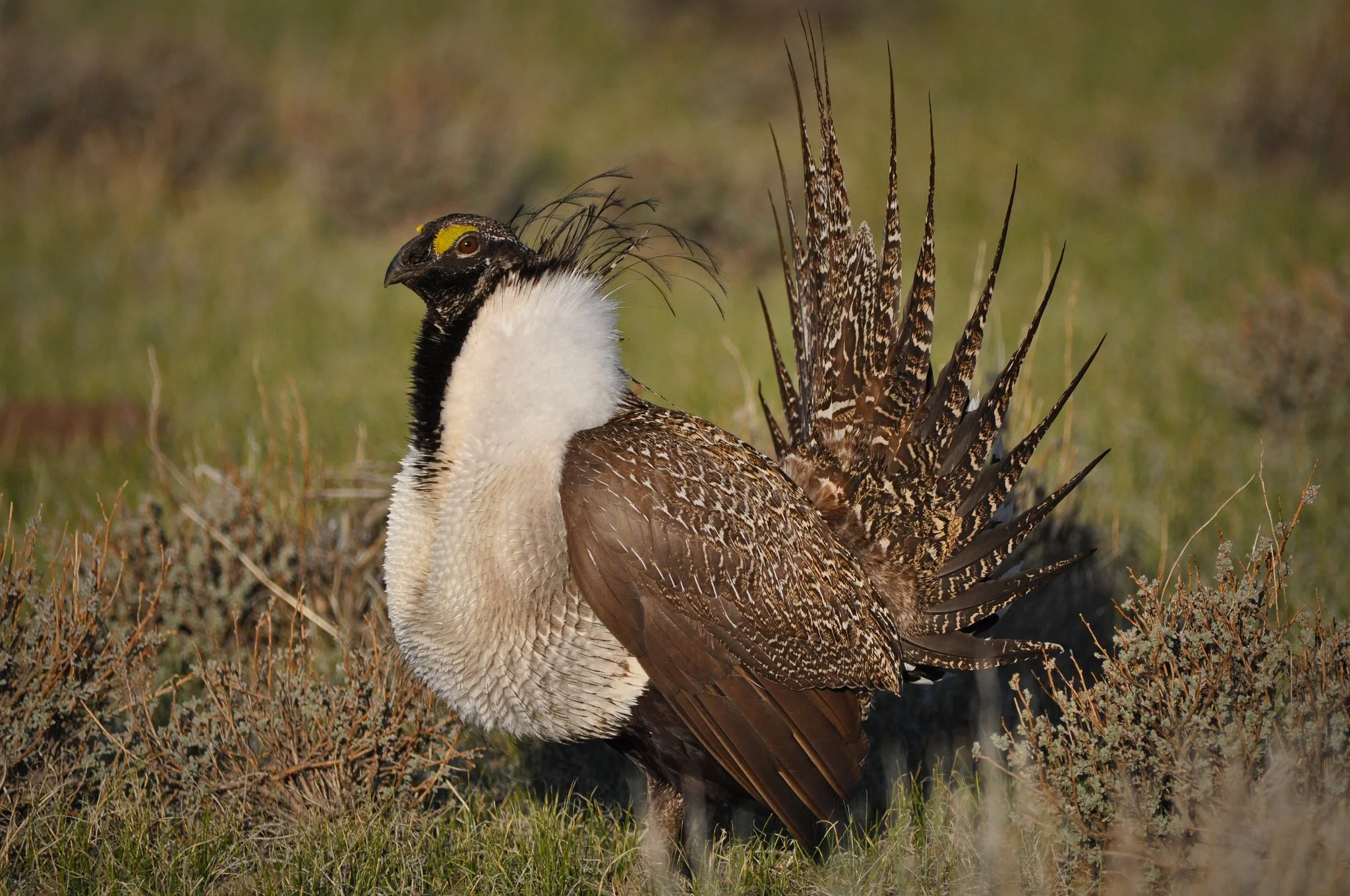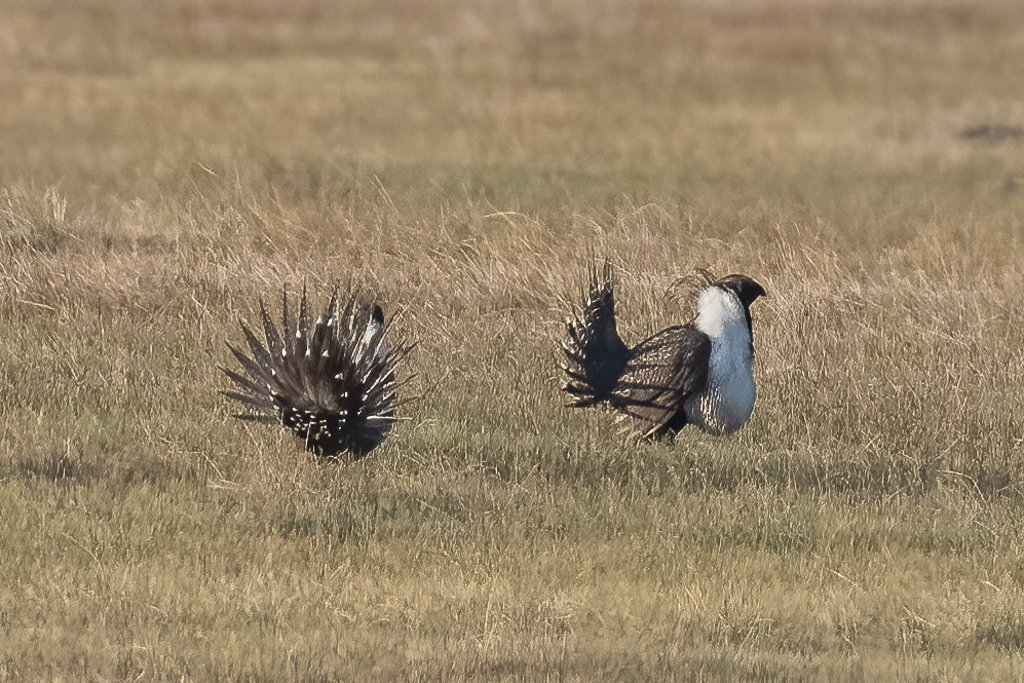By Robbie Lisa Freeman
The Bi-State population of Greater Sage-Grouse of the Eastern Sierras is a keystone species that for thousands of years has been genetically distinct from all other Greater Sage-Grouse occupying the Great Basin area across the western states. Photo courtesy of Jeanne Stafford/USFWS.
It’s been a long, bone-jarring drive down a dark and dusty rutted road. But finally, our caravan of eight vehicles pulls to a stop and 14 birders tumble out of their cars. Tucked into down jackets, gloves, face masks, and boots, we’re hoping to keep the bitter cold at bay. But as we gather our gear and strike out on our path, the 22-degree chill seeps insidiously through the stitching of even the best-made gloves and parkas. Before long, my fingers tingle from grasping the aluminum legs of the tripod and camera slung over my shoulder. But we are moving towards our target and my excitement exceeds my discomfort.
We’ve come to the Bi-State Greater Sage-Grouse lek to see a sacred ritual that our leader calls “one of the great treasures of California,” and “an honor and a privilege to observe.” It’s the annual breeding period of the Greater Sage-Grouse, and the male grouse have congregated to put on a centuries-old display intended to woo a female partner or two for conjugal affections.
“No talking, no whispering, no noise!” cautions our leader, Mary Freeman. We move slowly and silently in single file along a narrow path in an expansive field. All around me I hear popping sounds, like huge rain drops plopping into a pot of water. I instinctively lurch my head in the direction of each plop, but see only darkness. As we shuffle along in the pre-dawn light, there’s a sudden explosive sound, and I glimpse the silhouettes of dozens of grouse as they streak by us at speeds of up to 50 miles an hour! We all stand stunned as the birds disappear in the distance. Did we just flush the grouse we came so far to see? After a moment, we recover and continue on. But a few steps further, there’s another explosion and an additional dozen birds flash past us. We’d been told to expect only about 70 birds at the viewing site, so we’re now shrouded in concern that perhaps all of our “chickens” have flown the coop. But there’s no turning back at this point. Most of us have driven five to seven hours to be here. Our guides shepherd us forward. As we continue, I try to follow closely in the footsteps of the person in front of me, but stumble occasionally on a dark shrubby mound. Our trip leader’s words echo in my head: “Don’t step on the sagebrush. DON’T STEP ON THE SAGEBRUSH!” We’re on hallowed ground here – a protected region of grasslands near the mountains, an hour north of Bishop, California. Upwards of $45 million has been spent to protect and preserve this fragile eco-system of sagebrush — the essential diet of sage-grouse in winter.
Dozens of Greater Sage-Grouse flee the lek just as we are arriving. We later glimpse the Prairie Falcon that flushed the majority of birds from the area. Photo Courtesy of Paul Reinstein.
Wildfires, conifer expansion, drought, and invasive species are the biggest threats to sagebrush grasslands. Urbanization and human disturbance also affect sagebrush and sage-grouse. As we learned from our leader, even stepping on the sagebrush can impact the grouse. When disturbed, the wily sagebrush produces bio-defensive toxic terpenes to discourage grouse and other birds from eating them. Although the sage-grouse have a unique digestive system which separates the terpenes from the tender leaves, a higher concentration of terpenes emitted by disturbed or damaged plants can significantly affect sage-grouse foraging. I cringe to think I might have stumbled on a sagebrush.
Finally, we reach a gateway and our viewing destination for the morning: this is where the magic happens! The “lek,” loosely translated from Swedish to mean “play” or “play area,” is a flat prairie that offers a 360-degree view for the male birds to display themselves to females. The open space also allows the birds to watch for coyotes, eagles, and other raptors that are the key predators for a mature leking bird and for the chicks that will later hatch.
As dawn begins to brighten the fields, we set up a gallery of scopes and cameras aimed toward the lek and quickly we’re engrossed in grouse. Gazing out across the land, I can see them in the distance – the very far distance. There are several male Greater Sage-Grouse strutting their stuff. At first glance, they somewhat resemble turkeys, I think. But I look more closely to see their unique features: spikey, fanned tail feathers behind, a thick white feather “boa” around the neck, and wiry tufts of feathers on the head. Beautiful…but… wait. Whoa! I get a weird tingle as the bird suddenly starts to shape shift! Emerging from the thick white ruff are two expanding, pulsating golden balloons through which the bird emits booming, popping, and plopping sounds. These air sacs (cervical apteria) can grow 50 times larger in size during lekking, causing the bird’s serenading sounds to travel up to five miles. As if this isn’t enough to attract attention, the male also shakes his wings and tail feathers, prances, and poses in front of the assembled females. If another male gets too close, they seem to face off or even charge their competitors. Though I’m marveling at the spectacle, the female grouse seem unimpressed, sticking shyly to the sidelines, and even sidestepping the fellas that get too close.
The expansive Bi-State Greater Sage-Grouse lek is a flat prairie offering a 360-degree view that affords the male sage-grouse the opportunity not only to be seen by many females but also to keep an eye out for predators. Access to these private Department of Water and Power lands is restricted during breeding season to minimize impacts to the lek and birds. Photo by Robbie Lisa Freeman.
Remembering my camera, I focus and futz in an effort to capture the action. As I narrow in on one bird, suddenly every single grouse ducks down into the sagebrush, hidden from view. Our leaders, Mary and Nick, scour the field and a second later Mary murmurs “There’s a Prairie Falcon in the field!” All binocs swivel toward where she’s looking. There in the upper range of the field sits the raptor – the key culprit in the earlier flushing of so many grouse from the lek. A chorus of exclamations rises up from the group. We’re bummed to have had this falcon spook our birds. But then it dawns on me – with a tiny glimmer of glee – that this Prairie Falcon represents my second lifer in the first hour of our outing. Silver lining! I snap off some shots and return to the grouse, which have now resumed their rituals.
The Bi-State Greater Sage-Grouse come back each spring between March and May to carry out their mating rituals at the lek. Their displays can begin pre-dawn and last for many hours, then start up again at dusk. Photo courtesy of Paul Reinstein.
In respectful silence we continue observing the dances. I shake up a small heat pack and stuff it into one glove, while taking in the majesty of the snow-dusted mountains and appreciating the serenity of the moment. Then one birder alerts us of a magical happening – in an instant of grouse passion, a male gets lucky and we witness a quick mating. A gush of appreciation goes up from our group as we marvel at the moment. Few get the opportunity to see this grand mating display in person. Even fewer will ever see this particular species of Greater Sage-Grouse.
The Bi-State population of Greater Sage-Grouse of the Eastern Sierras is a keystone species that for thousands of years has been genetically distinct from all other Greater Sage-Grouse occupying the Great Basin area across the western states. This critical habitat, a 170-mile long and 60-mile-wide tract along the California-Nevada border, is monitored by federal, state, and local land management agencies in collaboration with local ranchers, Native American Tribes, private land owners, and nonprofit groups. All are part of the Bi-State Local Area Working Group, formed in 2002. Today, it is one of the nation’s leaders in sage-grouse conservation and a model for collaborative conservation.
While that is something to celebrate, there is much work to be done, according to Amy Sturgill, the Bi-State Coordinator who met with our group to educate us on sage-grouse. The latest research estimates that there are only about 3,300 birds in the whole bi-state population, far below the 5,000-bird threshold that scientists consider the minimum viable population. And across North America’s “sagebrush sea,” populations have declined significantly over the decades. Sage-grouse historically ranged over 15 western states and three Canadian provinces and were so prolific that explorers described flocks that, in flight, “darkened the skies.” It has been estimated that more than 16 million birds once roamed the sagebrush sea. But now, with habitat shrinking to 11 western states and only two Canadian provinces, the total Greater Sage-Grouse population is estimated at only 200,000 to 500,000 birds.
To attract a mate, the male Greater Sage-Grouse fans its spikey tail feathers and inflates two golden air sacs in its throat through which it emits booming, popping sounds. These air sacs can increase up to 50 times larger in size during the mating rituals. Photo courtesy of Bob Wick.
In a glimmer of hope, in May 2022, a federal court reinstated a 2013 proposal to list the Bi-State Greater Sage-Grouse as threatened under the Endangered Species Act and ordered the U.S. Fish and Wildlife Service to issue a new listing. And across many “sagebrush sea” regions, states are beginning to realize that they have a financial as well as ecological incentive to save their sagebrush habitat: It generates hundreds of millions of dollars for rural economies through wildlife tourism, hiking, camping, and hunting. Towns need these wild places as much as the birds do.
Our group of 14 birders, led by Mary and Nick Freeman, were graced to witness the majesty of the mountains, the beauty of the meadows, and the exotic mating rituals of the Greater Sage-Grouse. Photo by Robbie Lisa Freeman.
As we pack up our gear to leave the lek, I imagine how it might have been to live in a time when sage-grouse numbered so many that they darkened the skies in flight. Could the pioneers of those days have ever imagined a time when these plentiful birds would be teetering so close to the brink of extinction? Would they have been more thoughtful, more restrained in their treatment of the land and the wildlife? Would they have taught their children to be better stewards of nature? I amble back down the path with a bit more care. I’m thankful to have witnessed this ritual and am hopeful for the new generation of grouse that will have been bred right in this spot. And I’m thankful, too, for those working so hard to hold the line on the declining populations, so that future generations of birders and other nature lovers can experience this magical ritual.
To learn more about the recent federal ruling on the Bi-State Greater Sage-Grouse protections, visit www.biologicaldiversity.org or https://bit.ly/3A6CPNm. To learn more about the Bi-State Sage-Grouse Local Area Working Group, contact them at www.bistatesagegrouse.com. To learn more about future trips to view the Greater Sage-Grouse, contact Nick and Mary Freeman at mnfreeman@earthlink.net







